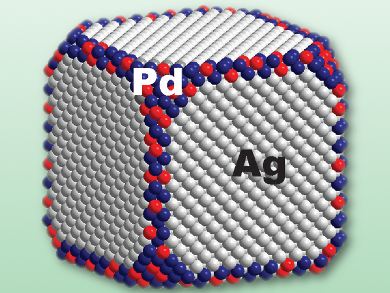Aromatic azo compounds are high-value chemicals extensively used in industry. However, their production typically requires stoichiometric amounts of environmentally unfriendly metals or nitrites. There is a need to develop a dual system capable of catalyzing the reduction of nitroaromatics to aromatic amines, followed by their subsequent oxidation to azo compounds.
Dong Qin and colleagues, Georgia Institute of Technology, Atlanta, USA, have developed a dual catalytic system based on Ag-Pd bimetallic nanocrystals. The team studied the stepwise conversion of 4-nitrothiophenol to trans-4,4′-dimercaptoazobenzene. They used core-frame nanocubes with Ag in the core and Pd at the edge and corner sites as the catalyst (pictured).
By immobilizing the reactants on the surface of the catalyst, the researchers were able to use surface-enhanced Raman spectroscopy (SERS) to monitor the reaction kinetics under different experimental conditions, as well as to identify reaction intermediates. They found a Pd-catalyzed reduction of 4-nitrothiophenol to 4-aminethiophenol and an Ag-catalyzed oxidation of 4-aminothiphenol to trans-4,4′-dimercaptoazobenzene. According to the team, this research could lead to the development of an environmentally friendly and sustainable approach to the production of aromatic azo compounds.
- A Dual Catalyst with SERS Activity for Probing Stepwise Reduction and Oxidation Reactions,
Jumei Li, Yiren Wu, Xiaojun Sun, Jingyue Liu, Sarah A. Winget, Dong Qin,
ChemNanoMat 2016.
DOI: 10.1002/cnma.201600153



